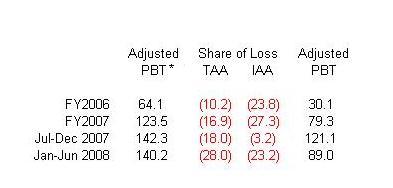While studying a company, many people will focus on examining the financial statements of the company, and tends to ignore the lengthy, multipages notes in its annual reports.
In this article, I just like to show an example, to demonstrate the importance of going through all those notes in order to get a correct picture on a company.
Recently, there are analysts keep calling that “it’s time to accumulate good quality stocks, their prices are so cheap and are undervalued.” Last week for example, I saw a buy list on news paper that recommended investors to buy companies with healthy balance sheet.

Well, since the “professionals” suggested that MAS had a healthy balance sheet, I guess we should at lease have a glance on its financial statements.
According to its latest annual reports, the balance sheet item of MAS is as follow:
- Non-current Assets: RM 2.63 billion.
- Current Assets: RM 7.42 billion
- Current Liabilities RM 5.25 billion.
- Non-current Liabilities: RM 0.86 billion.
- Equity to shareholders: RM 3.93 billion.
See any attractiveness in these figures?
Let’s go into more details. On its balance sheet, we’ll see that the current liabilities of MAS are mainly trade-payables and sales-in-advance, which are non-interest-bearing liabilities. The total debt (borrowing) of MAS is just about RM 0.9 billion, while it is holding about RM 5.3 billion of cash. In other words, MAS is having a net cash position of RM 4.4 billion!
Wow, this is really good, as the saying, a great balance sheet.
What’s the pitfall that lies behind this “healthy balance sheet”?
If you had gone through the footnotes in its annual reports, you’ll get some clue. MAS is actually having a huge amount of debt that is not reflected on its balance sheets -- what we called “off balance sheet items”. The most significant figures come from "operating lease arragement".
As we know, most of the aircrafts operated by MAS are not owned by itself. Instead, it leased the aircrafts from other parties and MAS had to pay rental fee on the aircrafts. The fact is, aircraft-leasing contracts are normally long-term arrangements, which are unlikely to be terminated earlier without penalty. Though they are not categorized as debt on the balance sheets, these contracts actually have the same effect as a real debt does on MAS’ cash flow -- MAS is obligated to make periodical payments on these contracts.
According to its FY2007 annual report (note 35, page-217), the amount of Operating Lease Arrangements of MAS at the balance sheet date are as follow:
- due within one year: RM 1.92 billion
- due between one and two years RM 1.91 billion
- due between two and five years: RM 3.23 billion
- due after five years: RM 1.72 billion
The total amount is RM 8.78 billion!

Taking these items into consideration, the financial position of MAS is nowhere near to ‘healthy’.
.
Let's end this article with some great definitions for financial jargons: (copied and pasted from Dali's blog.)
- EBITDA - Earnings Before I Tricked the Dumb Auditor.
- Off Balance Sheet Items - More important than items in the balance sheet, and represent things that really should be in the balance sheet.
- Economist - Someone who tells you why their predictions went wrong after every quarter, and proceeds to give a confident prediction for the next 3 quarters.
- Short Term Investor - Someone who is in-and-out within 3 days or less.
- Long Term Investor - A short term investor who cannot get out profitably after 3 days.
- Momentum Investing - The fine art of buying high and selling low with the crowd.
- Value Investing - The art of buying low and selling lower.
.


